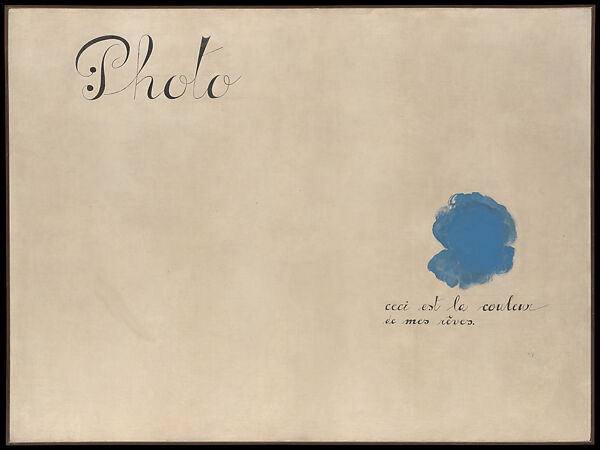Blue, "this is the color of my dreams," wrote Joan Miró.
This fragment, painted on canvas, sheds light on his sensitive and almost telluric connections with this world made of in-between worlds, the Mediterranean. From his island of Mallorca, he constantly scrutinized its shores, where he would search for driftwood on the beach, sculpted by the surf, where he would immerse himself in the intoxication of his dreams, crossed by the playful evidence of an immensity within reach.
Returning from an initiatory journey to New York, beyond the great urban clamor, the profusion and tumult of the city and its museums, he encounters Rothko's work. The shock is immense, faced with the unspeakable, the impalpable, this expanse of colors on the canvas that vibrates, sometimes shakes to the core, and gives rise to a form of levitation. This mystique, sensitive, speaks surprisingly to Miró. He then seeks to reinvent himself, to enter into a beyond of play with forms and their multiple whims. In this universe overwhelmed by color, he finds something like an enigma, a pictorial adventure that he has never managed to grasp until now. This inner upheaval, Miró will make into a foundational work.
The Immensity of Blue
Back in Mallorca, he lets himself be carried away by the immensity of color, by this Blue that is right there, before his eyes, between sky and sea, like a secret evidence. He will capture its shocks and mysterious forces. Like a bow, focused on its target, he will launch his arrows with no other destination than his inner demand. He loses himself, literally merges into the Blue, and shoots three arrows, those of his triptych in Blue, among the most powerful works of 20th-century art.
Miró touches on the evidence of mystery, on that part of the invisible that constitutes and disturbs us, subtle matter that pulls us upward, in the face of all collapses.
A Foundational Work
Being in front of these Blues by Miró is to live an unprecedented experience of sight, an initiatory quest for the marvelous unknown that suddenly appears, in the surface, then the meanders of the canvas. From its striations, its stains like ellipses that rhythm these Blues, with a bit of red and black, reality clings to the edge of the sensible world, it is not abolished by the immensity of color. It remains in its place, never capital. The "too much reality" does not impose its supremacy; it is another world that comes, that of art, precisely, where a sacred part can be glimpsed, in the profane world, which elevates us and never overwhelms us.
I once experienced this, this inner upheaval that leaves an indelible mark. It was during the inaugural exhibition of the Mucem - "Black and Blue. A Mediterranean Dream." I had to negotiate for a long time with the Centre Pompidou for the loan of this canvas by Miró, which was the very origin of this exhibition project. After many back-and-forths and hesitations, the loan was finally granted, and Miró's Blue II arrived at its destination, in Marseille. I remember being alone in the large exhibition hall, in front of the stretched frame of this Blue, placed on a large white wall.
I sat there and looked. Time was as if suspended, or abolished, I can’t quite remember, so rare was this experience. Miró appeared there, in the simplicity and immensity of his Blue. He spoke to all those who were willing to make themselves available, just to look, to enter his universe, a texture of embodied dreams.
"The Mediterranean dream," which was the very substance of this exhibition, narrated between the 18th and 21st centuries, found in Miró the echo of its presence, rhythmically and almost prolonged by these ellipses, in black, which open onto a story in the making, where the tragic collides with the momentum of dreams. The engravings of the "disasters of war," by Goya, placed right next to Miró, from the opening of the exhibition, were precisely there to never forget, the shadow of the Enlightenment...
A Moment Suspended at Mucem
Going into the blue, as Romain Gary invites us to do in this luminous expression found in one of his last books, "The Kites," living symbols of resistance against the excesses and oppressions of the Nazi order, is an incessant call. A tenacious lightness, the tireless desire to never be caught by the crushing power of things as they are. Gary's Blue, like Miró's, reminds us of this, vividly.
It is possible, at this moment, to reconnect with the immensity of these Blues by Miró. They are indeed on display at the Mucem, exceptionally thanks to a loan from the Centre Pompidou. To discover or rediscover, between June and November 2025, without moderation!


Thierry Fabre
Founder of the Rencontres d’Averroès, in Marseille.
Writer, researcher, and exhibition curator. He directed the journal La pensée de midi, the BLEU collection at Actes-Sud, and the programming of the Mucem. He created the Mediterranean program at the Institute of Advanced Studies of Aix-Marseille University.
He is responsible for editorial management.
Photo credit: The Metropolitan Museum of Art, New York. Gift of Mr. and Mrs. Joseph Pulitzer, Jr., 1951. Accession Number: 51.112.2. Image © The Metropolitan Museum of Art.
